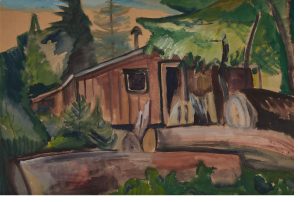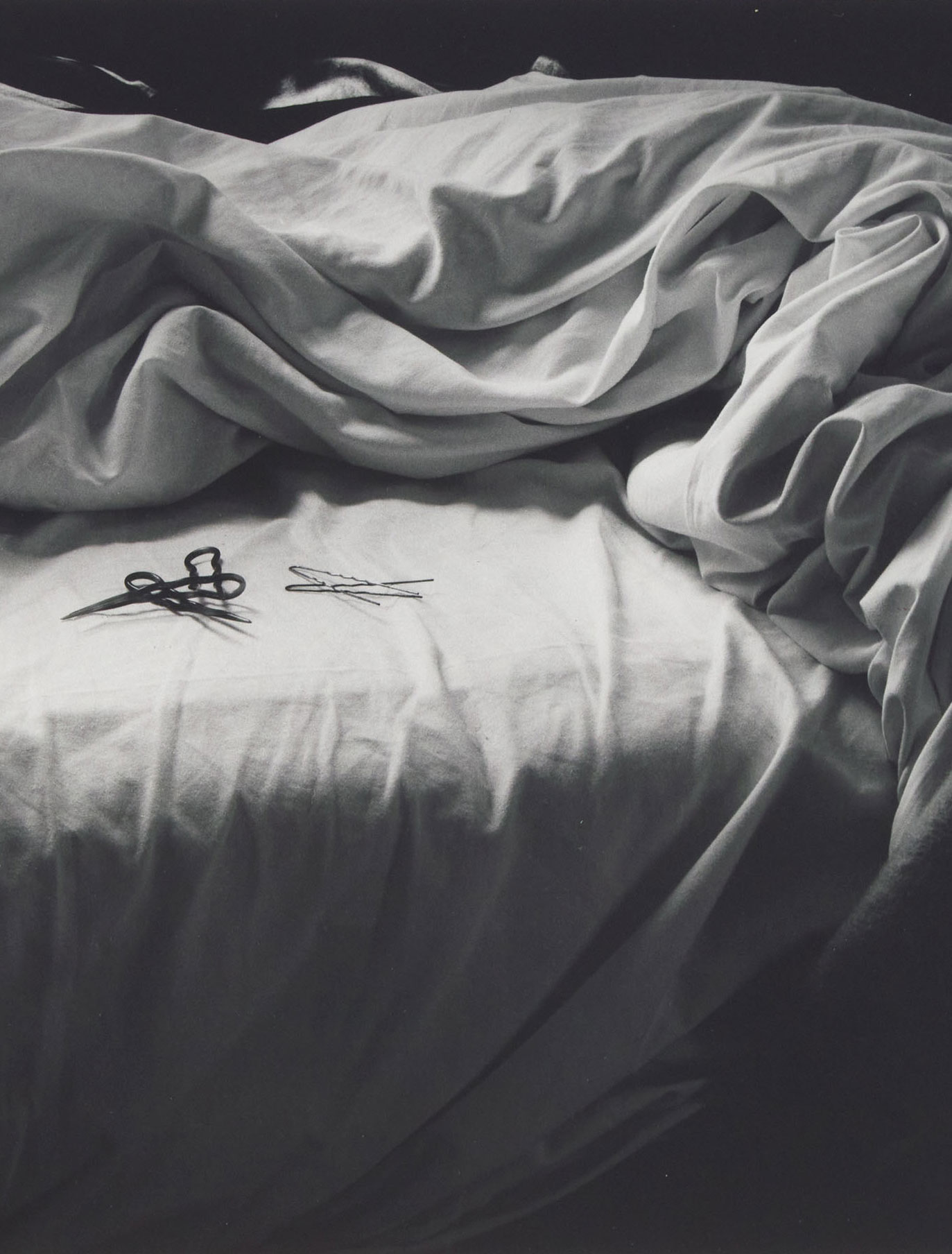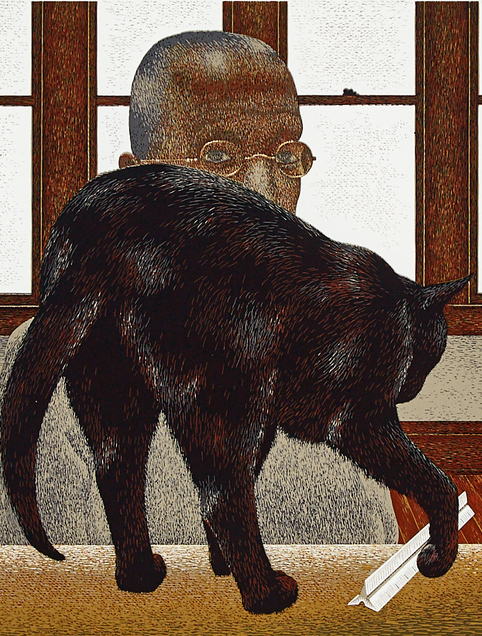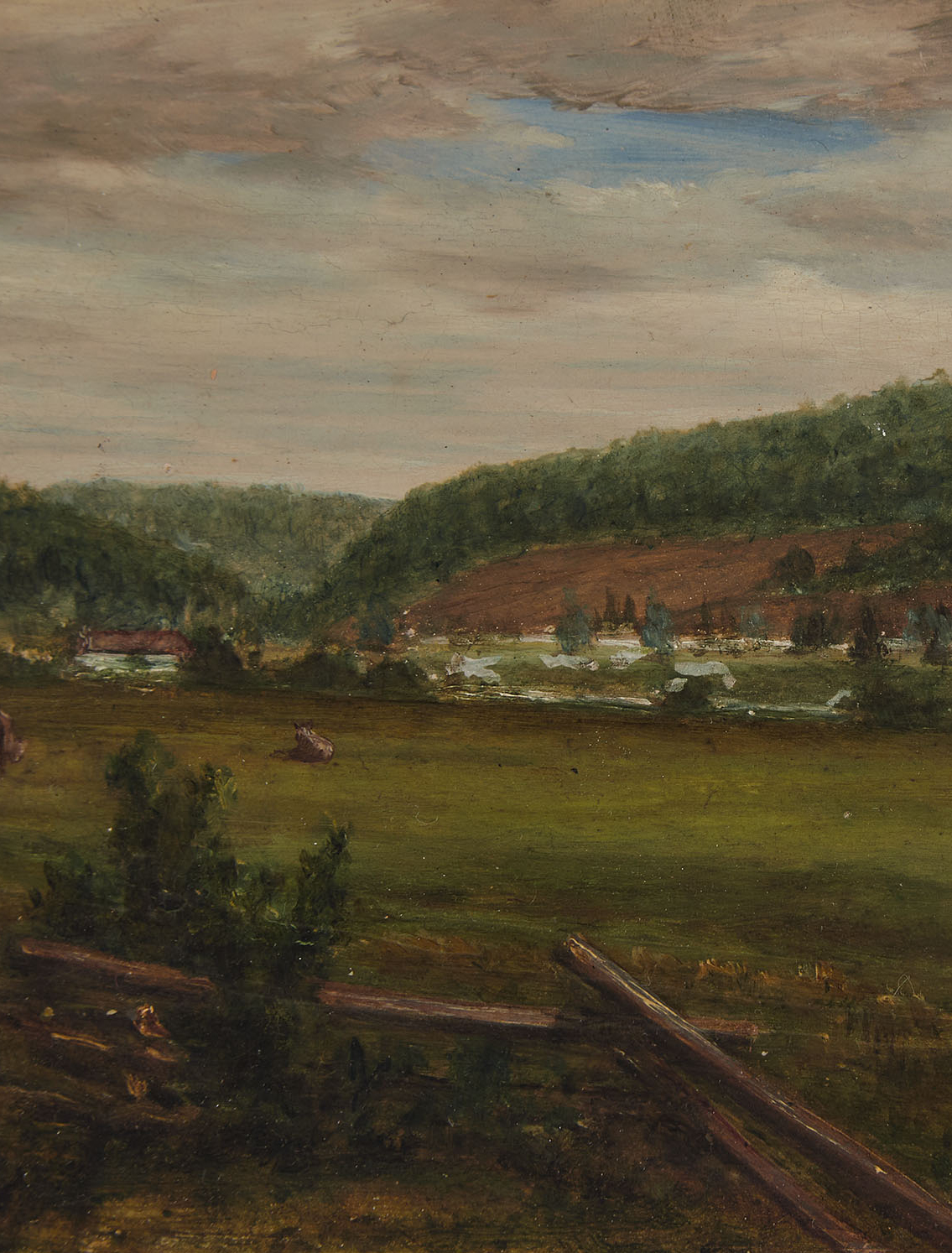
Doris Shadbolt calls the years between 1928 and 1932 some of the most productive and powerful for Carr: “she left behind the painterly approach she had used since her French sojourn and now translated what she saw in nature into simplified, solid, three-dimensional pictorial forms which she detached optically from the canvas surface and placed in deep space…This was also the period of her closest association with Harris and his strongest influence on her thought and her art; of her theosophic struggles; of Mark Tobey’s impact; and of her introduction to Walt Whitman’s writings.” (1)
Around 1930, Carr had switched from using watercolour to using diluted oil on paper when she worked en plein air. Watercolour was tricky to handle in the bush, and its thin and transparent texture did not allow Carr to fully express the sense of structure and complexity she was intent on capturing. Carr experimented with oil paint on board, card and paper, ultimately settling on the latter.
During this period, Carr found great inspiration in the endlessly varied scenery found outside of Victoria. She would plan sketching trips, immersing herself in nature for long periods of time. These trips were spaced months apart, and Carr would use the time in between to work up her fresh sketches into paintings. In Carr’s words:
“Sketching in the big woods is wonderful. You go, find a space wide enough to sit in and clear enough so that the undergrowth is not drowning you. Then, being elderly, you spread your camp stool and sit and look around. ‘Don’t see much here.’ ‘Wait.’ Out comes a cigarette. The mosquitoes back away from the smoke. Everything is green. Everything is waiting and still. Slowly things begin to move, to slip into their places. Groups and masses and lines tie themselves together. Colours you had not noticed come out, timidly or boldly. In and out, in and out your eye passes. Nothing is crowded; there is living space for all. Air moves between each leaf. Sunlight plays and dances. Nothing is still now. Life is sweeping through the spaces. Everything is alive. The air is alive. The silence is full of sound. The green is full of colour. Light and dark chase each other. Here is a picture, a complete thought, and there another and there… There are themes everywhere, something sublime, something ridiculous, or joyous, or calm, or mysterious. Tender youthfulness laughing at gnarled oldness. Moss and ferns, and leaves and twigs, light and air, depth and colour chattering…you must be still in order to hear and see. “ (2)
In a letter included with this painting, Shadbolt identifies “The Shack” as having been completed in Metchosin, a small coastal community on the southern tip of Vancouver Island in the summer of 1931. Carr stayed with her friend, M.E McVicker, while on a sketching trip, a short period after a similar trip to Cordova Bay in the spring of that year. An early example of Carr’s oil on paper paintings, “The Shack,” which depicts McVicker’s guest house, was given to her as a hostess gift.
Edythe Hembroff-Schleicher was with Carr on this trip to Metchosin, and wrote: “This trip was almost as prolific as the preceding one at Goldstream, but still more enjoyable as an outing because of our commodious and entertaining living quarters. The rolling hills, in which we snuggled, were glorious in colour and form, and we had absolute solitude except for a few curious friendly deer and a bear. An old and formidable friend of Emily’s, Mrs. McVicker, had lent us her tumble-down, but delightful “hunting lodge’. Unused for years, it was situated in a small clearing high up on Braden Mountain… It was here that Emily perfected the new sketching technique which, evolved largely for practical reasons, formed the basis of a completely different approach to her work. The cheap standard-size manila paper she was to use for sketching almost exclusively from then on provided a large painting surface on which to develop her woods subject; it also simplified exhibiting, storing and framing. Contrary to belief, this is the only time Emily camped in an isolated, thickly-wooded area during her trips of the thirties and forties… Many of Emily’s so-called rain forest paintings originated from this trip, including her masterpiece, ‘Grey.'” (3)
ABOUT THE AUCTION:
Waddington’s is pleased to present our major Canadian and International Fine Art auction, online from November 25-30.
This major auction features the Collection of Sir Christopher and Lady Ondaatje, which includes work by Cornelius Krieghoff, Frederick Verner and Sir William Cornelius Van Horne. Another key collection is that of Murdoch and Joyce Putnam, featuring paintings by A.Y. Jackson, A.J. Casson and Edwin Holgate. Other notable names include Max Liebermann, E.J. Hughes, William Perehudoff, Takao Tanabe, Jean McEwen, Edward Burtynsky and Jean-Michel Basquiat.
Please contact us for more information.
On view at our Toronto galleries, 275 King St. E, Second Floor:
Saturday, November 25 from 11:00 am to 4:00 pm
Sunday, November 26 from 11:00 am to 4:00 pm
Monday, November 27 from 12:00 pm to 7:00 pm
Tuesday, November 28 from 12:00 pm to 7:00 pm
Or by appointment.
(1) Doris Shadbolt, The Art of Emily Carr (Toronto and Vancouver: Douglas & McIntyre, 1979), 70.
(2) Shadbolt, 112.
(3) Edythe Hembroff-Schleicher, Emily Carr: The Untold Story, (Saanichton: Hancock House, 1978), 126-127.
Related News
Meet the Specialists

Liz Edwards
Director, Canadian Fine Art

Gregory Humeniuk
Senior Specialist

Kendra Popelas
Consignment Specialist










